Traditional Argentine clothing is a rich tapestry woven from diverse cultural influences and regional traditions. Rooted in both indigenous Argentine textiles and the Spanish influence on Argentine fashion, these garments tell stories of Argentina’s history and people. Iconic items like bombacha pants Argentina and the gaucho cowboy clothing reflect the rugged life of the Pampas region, while colorful Andean ponchos highlight the highland cultures.
In cities like Buenos Aires, traditional dress blends with modern styles, showing a dynamic fashion scene. Whether worn during cultural festivals clothing Argentina or daily life in rural Argentina attire, these clothes represent more than fabric—they celebrate Argentina’s identity and heritage.
Historical Roots of Argentine Attire

The history of traditional Argentinian clothing dates back to long before Spanish colonization. Indigenous communities wore simple clothes made from animal hides and woven indigenous Argentine textiles like cotton and wool. These materials were often dyed using plants, creating colorful and meaningful patterns. Clothing varied greatly depending on the climate, region, and tribe, showing the deep connection between people and their land.
When Spanish settlers arrived in the 16th century, they introduced new fabrics like silk and velvet. This brought a major shift. Wealthy classes favored these luxurious materials, while indigenous and rural people kept their natural fibers. The Spanish influence on Argentine fashion blended with native styles to create unique garments. This mix is the foundation for the clothing still worn today in festivals and daily life.
National Costume of Argentina
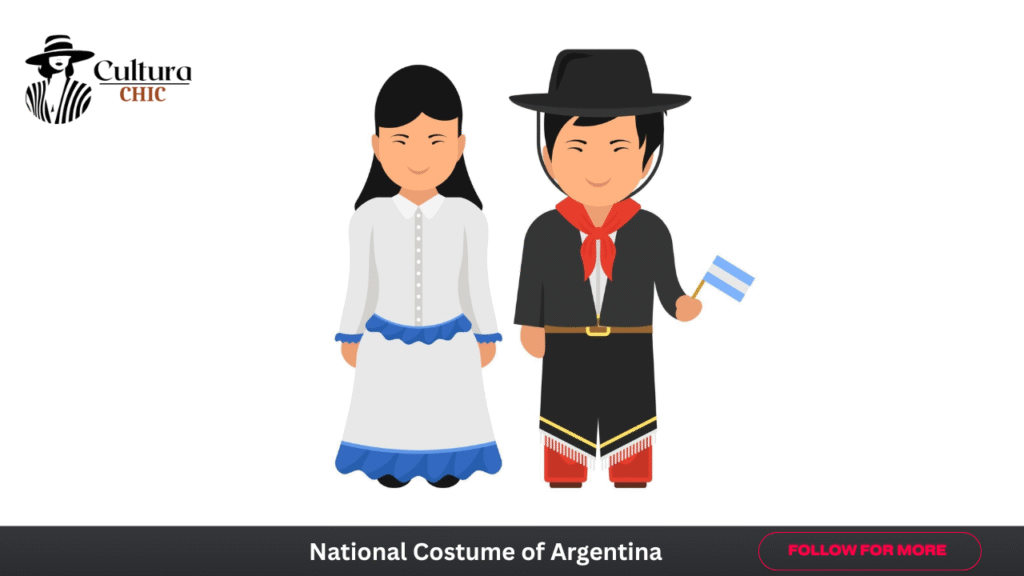
The national costume of Argentina is a symbol of pride and history. It includes traditional Argentine garments such as the poncho, bombacha pants, and gaucho hats. The poncho is a colorful, warm garment originally used by rural people to protect against the elements. It now represents Argentina’s spirit and heritage. These clothes often appear in cultural celebrations and dances, connecting Argentines to their past.
In addition to the poncho, bombacha pants Argentina style are loose and comfortable trousers worn mainly by men. This outfit shows the hard-working lifestyle of the Pampas region. Together, these pieces form the core of Argentina’s national costume. They are not just clothes but living symbols worn with pride.
Gaucho Style: Argentina’s Iconic Fashion Identity
Gaucho cowboy clothing is perhaps the most famous style tied to Argentina’s cultural heritage. Gauchos were skilled horsemen who roamed the Pampas. Their clothes were practical but became symbols of freedom and tradition. Gauchos wore wide-brimmed hats, ponchos, bombachas, and leather boots called botas de potro. Each item served a purpose, from protection to ease of riding.
The facón knife gaucho is another essential accessory. It was used for daily tasks and also represented a gaucho’s honor and skill. Today, gaucho clothing is celebrated during festivals and remains an icon of Argentina’s rural lifestyle. These clothes keep alive stories of bravery and simplicity.
Regional Variations in Traditional Argentine Clothing
Traditional clothing varies across Argentina’s regions, reflecting geography and history. In the Northwest, Andean ponchos made from llama and alpaca wool display bright colors and bold designs. These garments show strong indigenous influences and are perfect for cold mountain weather. Meanwhile, the Northeast prefers light cotton clothes with floral prints. Leather belts and silver buckles add a touch of elegance here.
Down in Patagonia and Tierra del Fuego, warmer clothes are essential. People wear thick wool garments with geometric patterns, leather boots, and fur coats to survive harsh winters. Central provinces like Córdoba and Santa Fe tend to have simpler linen and cotton clothing suited for milder weather. These regional differences in Argentine fashion reveal how culture adapts to environment.
Signature Argentine Garments and Accessories
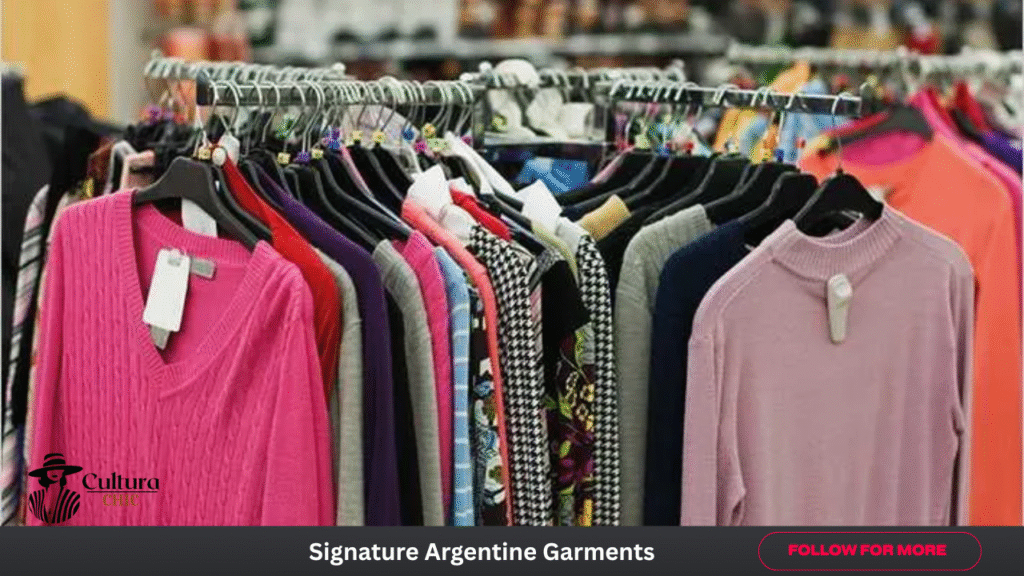
Several signature Argentine garments stand out. The poncho is a must-know, available in many styles, including the vibrant Andean versions and simpler rural ones. Men’s bombachas are loose trousers that symbolize the gaucho’s hard life. Women often wear pollera embroidered skirts, which are full and decorated with colorful patterns, especially at festivals.
Accessories are equally important. The facón knife gaucho and leather belts called cinturones complete the look. Spurs or espuelas worn by horse riders represent skill and tradition. Shoes like alpargatas shoes—light canvas footwear—are common in rural and urban areas. These items are not only practical but rich in cultural meaning.
| Garment / Accessory | Description | Cultural Significance |
| Poncho | Wool or alpaca cloak, loose and warm | Protection and national symbol |
| Bombacha Pants | Baggy trousers made of wool or cotton | Practical for riding, symbol of gaucho life |
| Pollera Skirts | Long, embroidered skirts worn by women | Festival wear, shows Argentine identity |
| Facón Knife | Ornate knife carried by gauchos | Tool and symbol of honor |
| Alpargatas Shoes | Simple canvas shoes | Everyday footwear with rural roots |
| Cinturones (Belts) | Decorative sashes often with metal details | Style and function in traditional dress |
Patterns, Fabrics, and Colors of Argentine Attire
The textures and colors used in traditional Argentine clothing reveal a lot about the culture. Wool and alpaca are common fabrics, perfect for Argentina’s varied climates. These materials are durable and warm, used especially in ponchos and Andean ponchos. Cotton and linen appear in lighter clothes, especially in warmer regions. Leather is used for boots and accessories, valued for strength and style.
Patterns often feature geometric shapes, bright embroidery, and earthy tones. Colors like deep reds, blues, and browns dominate. These designs are not just decorative; they tell stories and carry cultural meanings. The vibrant embroidery on pollera skirts shows artistic skills passed down through generations. This mix of materials and motifs creates a vivid visual language in Argentine fashion.
Modern Takes on Traditional Argentine Fashion
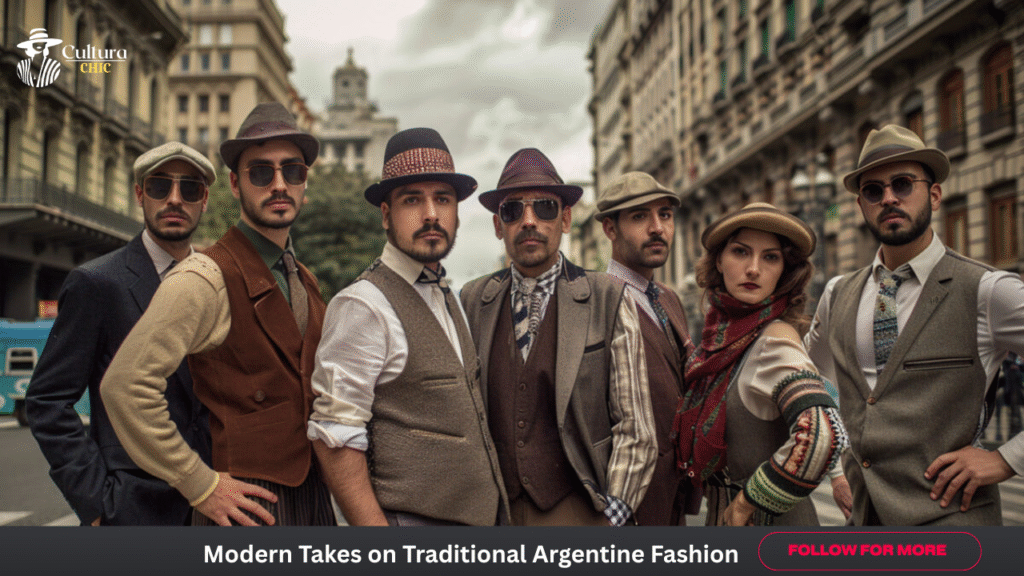
Modern designers in Argentina have embraced the past while looking forward. Modern takes on gaucho fashion include updated versions of ponchos and bombacha pants adapted for everyday urban wear. Leather accessories Argentina have become chic and trendy, combining craftsmanship with contemporary style. These pieces make traditional garments appealing to younger generations and international markets.
Even in Buenos Aires, traditional elements appear in street fashion. Designers incorporate hand-braided details and bold patterns inspired by indigenous and rural styles. This fusion keeps traditional Argentine clothing alive in the modern world. It shows how cultural heritage can evolve without losing its essence.
10 Must-Know Argentinian Clothing Brands
Argentina has a rich fashion scene with brands focused on heritage. Some blend tradition with modernity, offering unique takes on traditional Argentine garments. While a full list would be long, brands like Las Pepas, Ami Goods, and Ay Not Dead stand out. They create clothing inspired by gaucho style, bombacha pants Argentina, and leatherwork.
These brands often use local materials like alpaca wool and hand-embroidered textiles. Many offer products online, making it easier to buy traditional Argentine attire from anywhere. This growing market helps preserve cultural crafts while appealing to global fashion lovers.
Traditional Argentine Accessories & Symbolism
Accessories hold deep meanings in Argentine clothing. The facón knife gaucho is not only practical but a symbol of bravery. Leather accessories Argentina, such as belts and boots, reflect hard work and rural life. Spurs or espuelas worn by riders show skill and tradition in the Pampas region fashion.
Headwear like boinas (berets) protect from the sun and wind but also symbolize gaucho identity. Even simple items like alpargatas shoes connect wearers to Argentina’s heritage. These accessories complete the traditional look and keep cultural stories alive through every stitch and carving.
Argentine Fashion in Festivals, Dance & Folklore
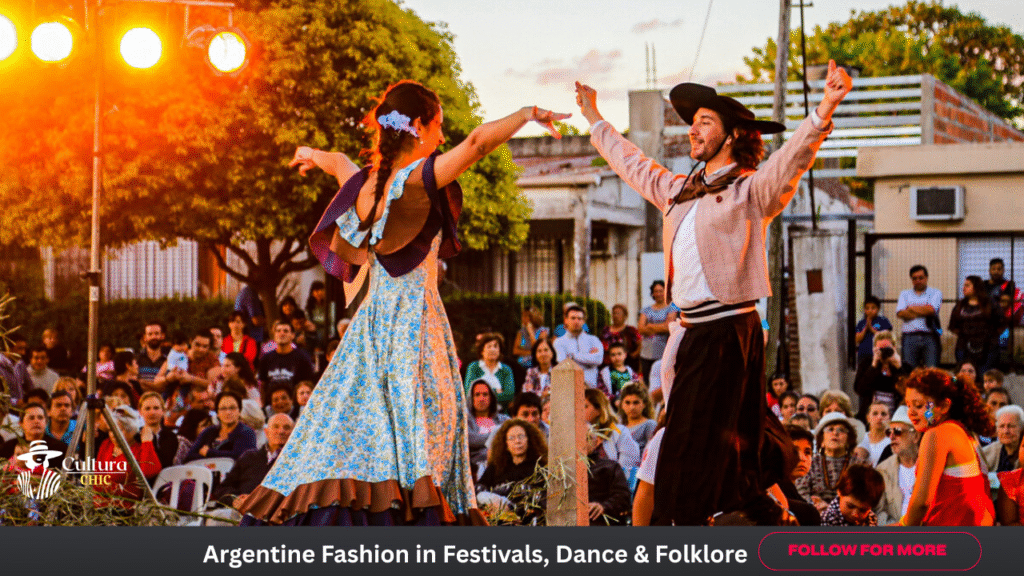
Traditional Argentine clothing shines brightest during festivals and dances. Events like the Fiesta Nacional del Gaucho showcase cultural festivals clothing Argentina in full glory. People wear gaucho cowboy clothing, pollera skirts, and colorful ponchos while dancing folkloric styles like chacarera.
These celebrations keep tradition alive. They allow locals and visitors to experience the beauty and meaning of Argentine dress. Wearing traditional clothing here is a way to honor ancestors and celebrate national pride, making festivals an essential part of Argentina’s cultural life.
Preserving Tradition: Where to See & Experience Argentine Fashion Today
To truly understand traditional Argentine clothing, visiting cultural sites is key. Museums in Buenos Aires and regions like Salta display historic textiles and garments. Cultural centers offer workshops where visitors learn about indigenous Argentine textiles and traditional tailoring techniques.
Markets and festivals provide lively places to see and buy authentic clothes. Tours focused on rural Argentina attire and gaucho culture offer firsthand experience. These opportunities help preserve fashion heritage and educate new generations, ensuring traditional Argentine clothing remains a living, breathing part of the country.
Conclusion
Traditional Argentine clothing is more than fabric and thread—it’s a living story of a nation. From the rugged gaucho cowboy clothing of the Pampas to the vibrant Andean ponchos of the Northwest, each garment holds meaning. This rich heritage, shaped by indigenous roots and Spanish influence, continues to thrive in modern styles and cultural events.
For anyone curious about fashion that tells a story, exploring traditional Argentine garments offers a rewarding journey. Whether through festivals, museums, or everyday wear, Argentina’s clothing connects the past to the present in colorful and meaningful ways.
This article used traditional Argentine clothing and its variations throughout to provide an informative, easy-to-read guide that will engage readers, especially those in the USA, interested in Argentina’s unique fashion heritage.
FAQS:
Q: What type of clothing do they wear in Argentina?
A: People wear both modern styles and traditional Argentine garments like ponchos, bombacha pants Argentina, and leather accessories, especially in rural areas and festivals.
Q: What is traditional clothing called?
A: Traditional clothing includes gaucho cowboy clothing, ponchos, bombachas, and pollera skirts, reflecting Argentina’s indigenous and Spanish heritage.
Q: What brands are made in Argentina?
A: Argentina is known for brands making Alpargatas shoes and quality leather goods, blending traditional craftsmanship with modern fashion.
Q: What is gaucho clothing?
A: Gaucho clothing features wide-brimmed hats, ponchos, bombacha pants Argentina, and the facón knife gaucho, symbolizing the cowboy lifestyle.
Q: What is the traditional culture of Argentina?
A: Argentina’s traditional culture combines indigenous customs, Spanish influences, and rural lifestyle, celebrated through clothing, dance, and festivals.
Welcome to Cultura Chic! I’m CHAUDHARY ALI, an AI-Powered SEO, and Content Writer with 2 years of experience.
